Today’s Current Affairs: 23rd Sep 2023 for UPSC IAS exams, State PSC exams, SSC CGL, State SSC, RRB, Railways, Banking Exam & IBPS, etc
Table of Contents
World Rhino Day 2023:
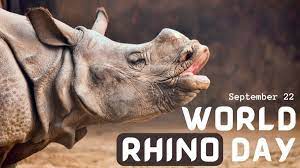
World Rhino Day is observed on 22nd September.
- World Rhino Day 2023 observed on 22th September.
- Objective is to spread awareness for all five species of rhino and the work being done to save them.
- It was first announced by WWF-South Africa in 2010.
- This special day provides the opportunity for cause-related organizations, NGOs, zoos, and members of the public to celebrate rhinos in their own unique ways.
- The scientific name and conservation status of the five species are: –
- Javan Rhinos (Rhinoceros sondaicus): Critically Endangered
- Sumatran rhinos (Dicerorhinus sumatrensis): Critically Endangered
- Black rhinos (Diceros bicornis): Critically Endangered
- White rhinos (Ceratotherium simum): Near Threatened (Southern white rhino)
- Greater One-Horned Rhinos (Rhinoceros unicornis): Vulnerable
Indian One-Horned Rhino:-
- The greater one-horned rhino (or “Indian rhino”) is the largest of the rhino species.
- Distribution: Nepal, Bhutan, Pakistan, and Assam, India.
- The greater one-horned rhino is identified by a single black horn about 8-25 inches long and a grey-brown hide with skin folds, which gives it an armour-plated appearance.
- The species is solitary, except when adult males or rhinos nearing adulthood gather at wallows or to graze.
- Conservation Status:-
- IUCN Red List: Vulnerable.
- CITES: Appendix-I
- Wildlife Protection Act, 1972: Schedule I.
Bima Sugam:

The Insurance Regulatory and Development Authority of India (IRDAI) is creating the ‘Bima Sugam’ online platform, which is described as a ‘game-changer’ and a ‘UPI moment’ for the insurance sector.
- It will serve as a one-stop destination for insurance-related needs, including policies, portability, agent changes, and claims.
- Buyers can directly purchase life, motor, or health policies through web aggregators, brokers, banks, and insurance agents. Insurance companies will be major shareholders in the platform, which will offer services via an ‘e-insurance account’.
- The platform aims to centralize data, facilitate policy porting, offer a wide range of policy choices, reduce intermediary commissions, and enable the acceptance of new products.
- The launch date for Bima Sugam is set for June 2024, following delays from the original deadlines.
IRDAI :
- The Insurance Regulatory and Development Authority of India (founded 1999; HQ: Hyderabad) is a statutory body (under the IRDA Act 1999) and is under the jurisdiction of the Ministry of Finance and is tasked with regulating and licensing the insurance and re-insurance industries in India.
Carrying Capacity Assessment:

Carrying Capacity Assessment is a tool for protecting hilly areas through sustainable tourism. It highlights the growth of tourism globally and its impacts, both positive and negative, on hilly regions.
- Carrying capacity refers to the maximum number of people a tourist destination can accommodate without harming the environment or the quality of visitor satisfaction.
Five components of carrying capacity:
- Physical Carrying Capacity (PCC): The maximum number of people a destination can physically accommodate without causing harm or degradation. Example: The national park can handle 1,000 visitors per day based on available parking and trails.
- Social Carrying Capacity (SCC) :The perceptual and psychological capacity of a place, considering visitor experience and impact on local residents.Example: Quiet beach town maintains a tranquil atmosphere with a limited number of visitors.
- Infrastructure Carrying Capacity (ICC) :The capacity of man-made facilities (hotels, parking, etc.) to support tourism activities. Example: Ski resorts can handle a certain number of skiers based on available lifts and lodges.
- Environmental Carrying Capacity (ECC) : Number of tourists a site can sustain without harming the natural environment. Example: The fragile coral reef has a low ECC to protect it from damage by snorkelers or divers.
- Economic Carrying Capacity (ECC) :The balance between tourism’s economic impact and the local economy benefits businesses without overwhelming them. Example: The small tourist-dependent town has an ECC to ensure economic benefits while maintaining community well-being.
Indian government Suspended Visa Services In Canada:
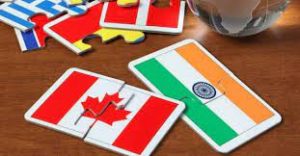
As diplomatic tensions between India and Canada escalate, the Indian government has suspended visa services in Canada, affecting a range of travelers and sparking questions about the future of diplomatic relations.
- Indian-origin Canadians with valid Overseas Citizen of India (OCI) cards or valid long-term Indian visas are not affected by the visa service suspension.
- OCI cardholders have lifetime entry privileges into India, allowing them to live and work in the country indefinitely.
- Canadians who possess valid Indian visas will not be impacted by the suspension. Their visas remain valid until further notice.
- Canada has not yet imposed restrictions on Indian visa applicants but may consider reciprocal measures in response to the current situation.
Announcement Of New Science Awards:

The Government of India has come out with a new set of National Awards in the field of science, technology, and innovation known as “Rashtriya Vigyan Puraskar”.
- Rashtriya Vigyan Puraskar award is to recognize the notable and inspiring contribution made by the scientists, technologists, and innovators individually or in teams in various fields of science, technology and technology led innovation.
- It shall be one of the highest recognitions in the field of science, technology, and innovation in India.
- Scientists/ technologists/innovators working in government, private sector organizations or any individual working outside any organization, who have made distinguished contributions in terms of path-breaking research or innovation or discovery in any field of science, technology, or technology- led innovation shall be eligible for the awards.
- People of Indian Origin staying abroad with exceptional contributions benefiting the Indian communities or society shall also be eligible for the awards.
- The awards shall be given in following four categories:-
- Vigyan Ratna (VR) award will recognize lifetime achievements & contributions made in any field of science and technology.
- Vigyan Shri (VS) award will recognize distinguished contributions in any field of science and technology.
- Vigyan Yuva-Shanti Swarup Bhatnagar (VY-SSB) award will recognize & encourage young scientists up to the age of 45 years who made an exceptional contribution in any field of science and technology.
- Vigyan Team (VT) award to be given to a team comprising of three or more scientists/researchers/innovators who have made an exceptional contribution working in a team in any field of science and technology.
State Of Working India 2023 : Report
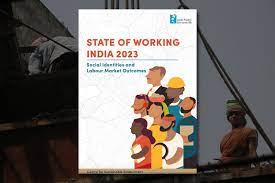
Azim Premji University’s Centre for Sustainable Employment has released the Report titled- “State of Working India 2023” highlighting the State of Indian workforce.
- It covers unemployment rates, women’s participation, intergenerational mobility, and caste-wise workforce dynamics.
- The report used various data sources like surveys conducted by the National Statistical Office including Employment-Unemployment Surveys and Periodic Labour Force Surveys along with the India Working Survey.
Highlights of the Report:
- After stagnating since the 1980s, the share of workers with regular wage or salaried work started increasing in 2004, going from 18% to 25% for men and 10% to 25% for women.
- Between 2004 and 2017, around 3 million regular wage jobs were created annually. Between 2017 and 2019 this jumped to 5 million per year.
- Since 2019, the pace of regular wage jobs creation has decreased due to the growth slowdown and the pandemic.
- In 2004, salaried women workers earned 70% of what men earned.
- By 2017 the gap had reduced and women earned 76% of what men did. Since then the gap has remained constant till 2021-22.
- The overall unemployment rate reduced to 6.6% in 2021-22 from 8.7% in 2017-18.
- However, for graduates under the age of 25, the unemployment rate was strikingly high at 42.3%.
- In contrast, those completing higher secondary education had a lower unemployment rate of 21.4%.
- Post the Covid-19 Pandemic, 60% of women were self-employed compared to 50% before.
- However, this increase in workforce participation was accompanied by a decline in self-employment earnings, reflecting the pandemic’s distressing impact.
- Intergenerational upward mobility has shown an upward trend, indicating socio-economic progress.
- 75.6 % of SC/ST men in casual wage work also had sons involved in casual wage work in 2018.
- There are changes in caste-wise workforce participation over the years.
- The share of SC workers in casual wage work has significantly reduced, but this reduction is more pronounced in the general caste category.
- For instance, in 2021, 40% of SC workers were involved in casual employment as compared to 13% of general caste workers.
- Furthermore, around 22 % of SC workers were regular wage workers as opposed to 32% of general caste workers.
- Economic growth has not proportionately translated into job creation, with the capacity to generate jobs declining as GDP (Gross Domestic Product) increases.
- The transition from agriculture to other sectors has not ensured a shift to salaried employment.
- Despite the aspiration for salaried employment, the majority of salaried work is informal, lacking contracts and benefits. Good salaried jobs with proper benefits are becoming less prominent.
- Graduate unemployment could be attributed to high aspirations and wage demands that the economy may not meet.
Global Report On Hypertension: The Race Against a Silent Killer
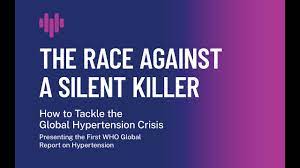
During the United Nations General Assembly’s (UNGA) 78th session, the World Health Organization (WHO) released a report titled “Global report on hypertension: The race against a silent killer.”
- It is the first-ever report by the WHO on the worldwide implications of hypertension, commonly referred to as high blood pressure.
Key Highlights of the Report:
- One in three adults across the world suffers from hypertension.
- The number of hypertension cases has doubled from 650 million to a staggering 1.3 billion between 1990 and 2019.
- Hypertension affects approximately 33% of adults aged 30-79 worldwide.
- Approximately four out of every five people with hypertension are not adequately treated.
- India alone has an estimated 188.3 million adults aged 30–79 years grappling with hypertension.
- The prevalence of high blood pressure in India is slightly lower than the global average of 31%.
- To reach a 50% control rate, India needs to ensure that an additional 67 million people with hypertension receive effective treatment.
- If the progress scenario were achieved, 4.6 million deaths due to high blood pressure would be averted by 2040.
- About 80% of individuals with hypertension do not receive adequate treatment.
- Effective hypertension treatment has the potential to prevent 76 million deaths, 120 million strokes, 79 million heart attacks, and 17 million cases of heart failure by 2050.
- Treatment coverage for hypertension exhibits significant disparities among countries, with high-income nations having a more favourable coverage rate.
- The WHO region of the US leads with a 60% coverage rate, while the African region lags behind at 27%.
- More than three-quarters of adults with hypertension live in low- and middle-income countries.
- Nearly 30% of individuals with uncontrolled hypertension exhibit blood pressure measurements above the threshold warranting urgent treatment.
- Globally, the percentage of adults aged 30–70 taking medication for hypertension has doubled from 22% in 1990 to 42% in 2019.
- Effective treatment coverage has quadrupled during the same period, reaching 21%.
- The WHO calls for prioritising the prevention, early detection, and effective management of hypertension as part of national health benefit packages.
Pterygotrigla intermedica : New Species Of Marine Fish

The scientists of the Zoological Survey of India (ZSI) have discovered a new species of vibrant orange-colored deep-water marine fish from Digha Mohana in West Bengal.
- Pterygotrigla intermedica is commonly known as gurnards or sea-robins and belongs to the family Triglidae.
- It is the fourth species of Pterygotrigla genus reported in India so far, and there are a total of 178 species of the Triglidae family worldwide.
- The specimens of this fish were found to be very distinct from other gurnad species in various aspects,such as snout length, shape of the internuchal space, and size of the cleithral spine.
- The scientists found a distinct pectoral-fin with black membranes on the inner surface, white posterior margin and three small white spots basally in fin, each ray creamy white on the new species
- It had a combination of characters like a long opercular spine and a very short cleithral spine.
- The lateral line, gill rakers on upper limb and 12–13 on lower limb of first gill arch, and a large black blotch between the 4th and 6th spines of the first dorsal fin.
Indian Skimmer : Recently Spotted
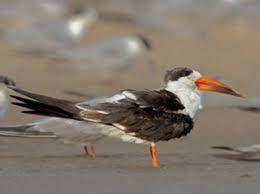
The endangered Indian Skimmer was recently spotted along the Ghaghra River at Dudhwa Tiger Reserve.
- Indian Skimmer is an odd bird which belongs to the family of skimmers, Rynchopidae.
- Scientific Name: Rynchops albicollis
- It gets its name from the way it feeds, flying low over the water surface and ‘skimming’ for fish.
- Other names: Indian scissors-bill
- It occurs primarily on larger, sandy, lowland rivers, around lakes and adjacent marshes and, in the non-breeding season, in estuaries and coasts.
- These skimmer species were distributed in north Indian rivers, Pakistan, Nepal, Bangladesh, Myanmar, China, Cambodia, Laos and Vietnam.
- About 20% of the total population nest along river Chambal.
- Conservation Status:
- IUCN Red List: Endangered
Adi Shankaracharya : Statue
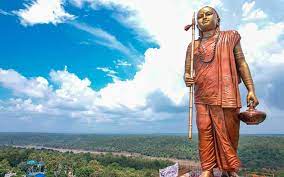
The Madhya Pradesh Chief Minister recently unveiled a 108-feet statue of Adi Shankaracharya, an 8th-century Vedic scholar and teacher, in Omkareshwar.
- Adi Shankaracharya was an ancient Indian philosopher and theologian who lived in the early 8th century CE.
- He was born in Kalady, a village in present-day Kerala.
- He is best known for his role in the development and propagation of Advaita Vedanta, a non-dualistic school of Hindu philosophy.
- He amalgamated the ideologies of ‘Advaita Vedanta’ and also explained the basic ideas of Upanishads.
- His most important work is his efforts to synthesize the six sub-sects, known as ‘Shanmata.’ ‘Shanmata’, which literally translates to ‘six religions,’ is the worship of six supreme deities.
- Shankaracharya explained the existence of one Supreme Being (Brahman) and that the six supreme deities are part of one divine power.
- He established four prominent monastic centers in India, each associated with one of the cardinal directions: Sringeri in the south, Dwarka in the west, Puri in the east, and Badrinath in the north.
- He wrote 18 commentaries on major religious scriptures like the Bhagavad Gita, Brahmasutras, and 12 major Upanishads.
- His review of ‘Brahma Sutra’ is known as ‘Brahmasutrabhasya’, and it is the oldest surviving commentary on ‘Brahma Sutra’.
- He wrote 23 books on the principles contained in the Advaita Vedanta philosophy, including Viveka Chudamani, AtmaBodha, Vakya Vritti, Upadesa Sahasri, etc.
- 72 devotional hymns and meditational hymns like Soundarya Lahari, Nirvana Shatakam, Maneesha Panchakam.
- Adi Shankaracharya is believed to have attained Samadhi (a state of deep meditation or realization) at the young age of 32 in Kedarnath in the Himalayas.
Perovskite:
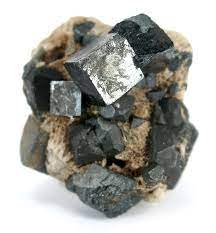
Scientists recently discovered that a nanoscale “ink” coating could improve stability enough to make next-generation perovskite solar cells suitable for mass production.
- Perovskites are a class of materials that share a similar structure and display a myriad of exciting properties like superconductivity, magnetoresistance, etc.
- It is a material that has the same crystal structure as the mineral calcium titanium oxide (CaTiO3), the first-discovered perovskite crystal.
- It is characterised by a three-dimensional arrangement of atoms.
- It has the general formula ABX3, where “A” and “B” represent cations (positively charged ions) and “X” represents anions (negatively charged ions).
- The mineral was discovered in the Ural Mountains of Russia by Gustav Rose in 1839 and is named after Russian mineralogist Lev Perovski.
- Due to its compositional flexibility, scientists can design perovskite crystals to have a wide variety of physical, optical, and electrical characteristics from insulating, semiconducting, metallic, and superconducting characteristics.
- They are known for their exceptional optical properties.
- They can efficiently absorb and emit light across a wide range of wavelengths, from visible to near-infrared.
- This property has made them a promising candidate for solar cells and light-emitting devices.
National Medical Commission : WFME Recognition Status
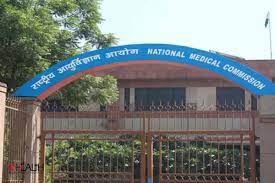
The National Medical Commission (NMC) of India has been recently awarded World Federation for Medical Education (WFME) Recognition status for a tenure of 10 years.
- WFME is a global organisation concerned with the education and training of medical doctors.
- WFME’s mission is to strive for better health care for all mankind.
- WFME’s primary objective is to enhance the quality of medical education worldwide, with the promotion of the highest scientific and ethical standards in medical education.
- It was founded in 1972 and is headquartered in Ferney-Voltaire, France.
- It is the organisation that officially and globally represents medical teachers and medical teaching institutions before the World Health Organization(WHO).
- WFME’s accreditation program plays a pivotal role in ensuring that medical institutes meet and uphold the highest international standards of education and training
Importance of WFME Recognition Status to NMC:
- It will enable Indian medical graduates to practice or pursue post-graduation in countries including the US, Canada, Australia, and New Zealand, where WFME recognition is a prerequisite.
- All 706 existing medical colleges in India have received WFME accreditation. Any new medical colleges established in the next 10 years will also automatically gain WFME accreditation status.
- It will enable the commission to enhance the quality and standards of medical education in India by aligning it with global best practises and benchmarks.
- It will also augment the international recognition and reputation of Indian medical institutions and professionals, foster academic collaborations and exchanges, and promote ongoing improvements and innovation in medical education.
National Medical Commission (NMC):
- NMC is a statutory body established under the National Medical Commission Act, 2019.
- The NMC replaced the erstwhile Medical Council of India (MCI), which was established in 1934.
Asia Pacific Forum On Human Rights : Conference

The President of India inaugurated Annual General Meeting and Biennial Conference of the Asia Pacific Forum on Human Rights in New Delhi.
- Asia Pacific Forum was founded in 1996.
- It has created a strong and united platform that brings together National Human Rights Institutions (NHRIs) from all corners of the Asia Pacific.
- It addresses some of the most serious human rights challenges in Asia Pacific region.
- It has 17 full members and eight associate members.
- India has been a full time member since 1996.
- To be admitted as a full member, a National Human Rights Institution must fully comply with the minimum international standards set out in the Paris Principles.
- National Human Rights Institutions that partially comply with the Paris Principles are granted associate membership.
- Decisions about the admission of new members to the APF are made by the Forum Council.
- A fundamental goal of the APF is to promote the establishment of independent NHRIsin the Asia Pacific region and to support our members to do their work as effectively as possible.
General Crop Estimation Survey Portal:

The secretary of the Department of Agriculture and Farmers Welfare (DA&FW) launched the mobile application and the web portal for GCES (General Crop Estimation Survey).
- General Crop Estimation Survey Portal and mobile application have been designed to transform agricultural practices across the nation.
- It has been developed by Department of Agriculture and Farmers’ Welfare.
- It has been developed for leveraging technology to enhance the reach, scope, and outcome of government actions in the course of development.
- The automation of the GCES process will ensure on time reporting of crop statistics and accuracy of the data.
- The portal and the app provide a comprehensive repository of yield estimation including village wise GCES plan and plot details where the crop cutting experiments are conducted, post harvesting crop weight and driage weight of the crop.
- It is one of the key features of the mobile application, which enables the primary worker to draw the boundary of the experimental plot and upload photos of the plot as well as of the crops through it.
- This feature will ensure transparency and accuracy of the data as well.




